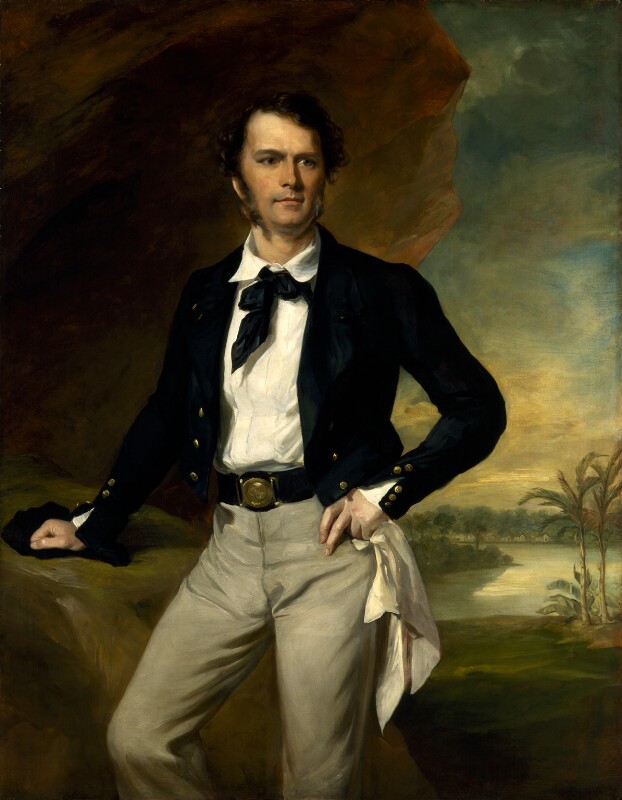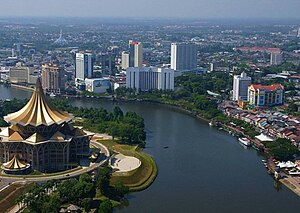History
The eastern seaboard of Borneo was charted, though not settled, by the
Portuguese in the early 16th century. The area of Sarawak was known to Portuguese
cartographers as
Cerava. During the 17th century, Sarawak was self-governed under Sultan Tengah. By the early 19th century, Sarawak had become a loosely governed territory under the control of the
Brunei Sultanate. During the reign of Pangeran Indera Mahkota in 19th century, Sarawak was facing chaos.
[7] Sultan
Omar Ali Saifuddin II (1827–1852), the Sultan of Brunei, ordered Pangeran Muda Hashim in 1839 to restore order and it was during this time that
James Brooke arrived in Sarawak. Pangeran Muda Hashim initially requested assistance in the matter, but Brooke refused. In 1841, Brooke paid another visit to Sarawak and this time he agreed to provide assistance. Pangeran Muda Hashim signed a treaty in 1841 surrendering Sarawak and Sinian to Brooke. On 24 September 1841, Pangeran Muda Hashim bestowed the title Governor to James Brooke. He effectively became the Rajah of Sarawak and founded the White Rajah Dynasty of Sarawak, later extending his administration through an agreement with the Sultan of Brunei. Sarawak was thus an independent kingdom from 1841 until 1888, when the state was placed under British protection.
Brooke Dynasty
James Brooke was appointed
Rajah by the Sultan of
Brunei on 18 August 1842. Brooke ruled the territory, later expanded, across the western regions of Sarawak around
Kuching until his death in 1868. His nephew
Charles Anthoni Johnson Brooke became Rajah after his death; he was succeeded on his death in 1917 by his son,
Charles Vyner Brooke, with the condition that Charles should rule in consultation with his brother
Bertram Brooke.
[8] The Sarawak territories were greatly enlarged under the Brooke dynasty, mostly at the expense of areas nominally under the control of Brunei. In practice Brunei had only controlled strategic river and coastal forts in much of the lost territory, so most of the gain was at the expense of Muslim warlords and of the de facto independence of local tribes.
The Brooke dynasty ruled Sarawak for a hundred years and became famous as the "
White Rajahs", accorded a status within the British Empire similar to that of the rulers of Indian
princely states. In contrast to many other areas of the empire, however, the Brooke dynasty was intent on a policy of
paternalism in order to protect the indigenous population against exploitation. They governed with the aid of the Muslim Malay and enlisted the Ibans and other "
Dayak" as a contingent militia. The Brooke dynasty also encouraged the immigration of Chinese merchants but forbade the Chinese to settle outside of towns in order to minimise the impact on the Dayak way of life. Charles Brooke, the second White Rajah of Sarawak, established the
Sarawak Museum, the oldest museum in Borneo.
In the early part of 1941 preparations were afoot to introduce a new constitution, designed to limit the power of the Rajah and give the people of Sarawak a greater say in government. Despite this democratic intention, the draft constitution contained irregularities, including a secret agreement drawn up between Charles Vyner Brooke and his top government officials, financially compensating him via treasury funds.
[9]
Second World War and occupation
Japan invaded Sarawak and occupied the island of Borneo in 1941, occupying Miri on 16 December and Kuching on 24 December, holding both territories for the duration of
World War II until the area was secured by Australian forces in 1945. Charles Vyner Brooke formally ceded sovereignty to the British Crown on 1 July 1946, under pressure from his wife among others. In addition, the British Government offered a healthy pension to Brooke.
Anthony Brooke continued to claim sovereignty as Rajah of Sarawak. After the end of the World War II, Anthony Brooke then opposed the cession of the Rajah's territory to the British Crown, and was associated with anti-secessionist groups in Sarawak. For this he was banished from Sarawak and he was allowed to return only seventeen years later, when Sarawak became part of Malaysia. Sarawak became a British colony (formerly an independent state under British protection) in July 1946, but Brooke's campaign continued. The Malays in particular resisted the cession to Britain, dramatically
assassinating the second British governor, Sir Duncan George Stewart.
Independence
Sarawak was officially granted independence on 22 July 1963, and joined with Malaya, Sabah, and Singapore, in the federation of
Malaysia,
[10][11] formed on 16 September 1963, despite the initial opposition from parts of the population.
[12][13] Sarawak was also a
flashpoint during the
Indonesian Confrontation between 1962 and 1966.
[14][15]
Geography
Having land area of 124,450 square kilometres (48,050 sq mi) spreading between latitude 0° 50′ and 5°N and longitude 109° 36′ and 115° 40′ E, it makes up 37.5% of the land of Malaysia. Sarawak also contains large tracts of
tropical rainforest home to an abundance of plant and animal species.
The state of Sarawak stretches for over 750 kilometres (470 mi) along the northeast coastline of Borneo, interrupted in the north by about 150 kilometres (93 mi) of Brunei coast. Sarawak is separated from the Indonesian part of Borneo (Kalimantan) by ranges of high hills and mountains that are part of the central mountain range of Borneo. These get higher to the north and culminate near the source of the Baram River with the steep Mount Selidang (4504 ft) at central plateau of Usun Apau, Mount Batu Lawi, Mount Mulu in the park of the same name and
Mount Murud with the highest peak in Sarawak.
The major rivers from the south to the north include the
Sarawak River, Lupar River, Saribas River, and
Rajang River, which is the longest river in Malaysia at 563 kilometres (350 mi). The Baleh River branch, the Baram River, and the Limbang River drains into the
Brunei Bayas it divides the two parts of Brunei and the Trusan River. The Sarawak river is 2,459 square kilometres (949 sq mi) in area and is the main river flowing through the capital of Kuching.
Sarawak can be divided into three natural regions. The coastal region is rather low lying flat country with large extents of swamps and other wet environments. The hill region provides most of the easily inhabited land and most of the larger cities and towns have been built in this region. The
ports of Kuching and Sibu have been built some distance from the coast on rivers. Bintulu and Miri are close to the coastline where the hills stretch right to the
South China Sea. The third region is the mountain region along the border and with the Kelabit (Bario), Murut (Ba Kelalan) and Kenyah (Usun Apau) highlands in the north.
Environment
Sarawak has vast areas of both lowland and highland rainforest. However, Sarawak has been hit hard by the
logging industry and the expansion of monoculture tree plantations and
oil palmplantations. Malaysia's deforestation rate is increasing faster than anywhere else in the world. Statistics estimate Sarawak's forests have been depleted but there is no definitive study to know how much.
Malaysia's deforestation rates overall are among the highest in Asia, jumping almost 86 percent between the 1990–2000 period and 2000–2005. In total, Malaysia lost an average of 1,402 km
2 —0.65 percent of its forest area—per year since 2000.
[16] By comparison, Southeast Asian countries lost an average of 0.35% of their forest per annum during the 1990s.
Demographics
Population[edit]
As of the 2010 census, the population of Sarawak was 2,399,839, making it the 4th most populous state in Malaysia.
[17] Due to the large area of Sarawak, it has the lowest
population density in Malaysia, which stands at 22 people per km
2. Sarawak also has some of the lowest population growth in Malaysia.












